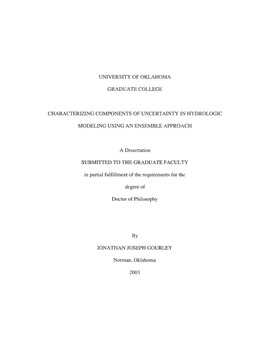| dc.contributor.advisor | Vieux, Baxter, | en_US |
| dc.contributor.author | Gourley, Jonathan Joseph. | en_US |
| dc.date.accessioned | 2013-08-16T12:19:16Z | |
| dc.date.available | 2013-08-16T12:19:16Z | |
| dc.date.issued | 2003 | en_US |
| dc.identifier.uri | https://hdl.handle.net/11244/679 | |
| dc.description.abstract | In hydrologic modeling, uncertainties are known to reside in model inputs, i.e., rainfall estimates, model parameters, observations of streamflow, and in some cases in the model structure itself. Estimation of the total prediction uncertainty for a hydrologic forecast first requires knowledge of the error characteristics of input rainfall estimates. Traditionally, evaluation of quantitative precipitation estimates (QPEs) has been accomplished by comparing remotely sensed rainfall to point rain gauge observations. In addition to errors associated with rain gauge measurements, it has been noted that sampling sizes between a typical radar pixel and a rain gauge orifice differ by about eight orders of magnitude (Droegemeier et al. 2000). It is thus highly desirable to design an objective, quantitative methodology that evaluates the skill of precipitation algorithms at the hydrologic scale of application, a watershed. QPEs from different algorithms are input to the Vflo(TM) hydrologic model. Thousands of simulations are performed in an ensemble fashion in order to "expose" each rainfall input to the entire parameter space. Probabilistic statistics are utilized to compare the predicted probability density functions (pdfs) to observations of streamflow. Results indicate the spatial variability of rainfall observed by radar is indeed important for skillful hydrologic predictions. | en_US |
| dc.description.abstract | The developed ensemble approach is also used to evaluate the propagation characteristics of error in rainfall estimates to hydrologic predictions. Predictions of peak discharge and time-integrated discharge volume are shown to be very sensitive to rainfall perturbations. Ensembles are then constructed to include the combined uncertainty in QPEs and model parameters. Several case studies are utilized to show how the total prediction uncertainty can be accurately estimated. Moreover, additional sources of uncertainty are identified for a case where simulation bounds derived from predicted pdfs do not replicate observed behavior during summer months. This may be due to inadequate parameterization (e.g., initial abstraction) or to model structure. Soil moisture observations from the Oklahoma Mesonet are introduced to reveal some explanation for conditions where the Green and Ampt submodel may not adequately characterize the infiltration behavior during summertime low flows. | en_US |
| dc.format.extent | xviii, 232 leaves : | en_US |
| dc.subject | Physics, Atmospheric Science. | en_US |
| dc.subject | Hydrological forecasting. | en_US |
| dc.subject | Hydrology. | en_US |
| dc.subject | Precipitation forecasting. | en_US |
| dc.subject | Precipitation probabilities. | en_US |
| dc.subject | Hydrologic models. | en_US |
| dc.subject | Geophysics. | en_US |
| dc.title | Characterizing components of uncertainty in hydrologic modeling using an ensemble approach. | en_US |
| dc.type | Thesis | en_US |
| dc.thesis.degree | Ph.D. | en_US |
| dc.thesis.degreeDiscipline | School of Civil Engineering and Environmental Science | en_US |
| dc.note | Source: Dissertation Abstracts International, Volume: 64-10, Section: B, page: 4833. | en_US |
| dc.note | Adviser: Baxter Vieux. | en_US |
| ou.identifier | (UMI)AAI3109074 | en_US |
| ou.group | College of Engineering::School of Civil Engineering and Environmental Science | |
